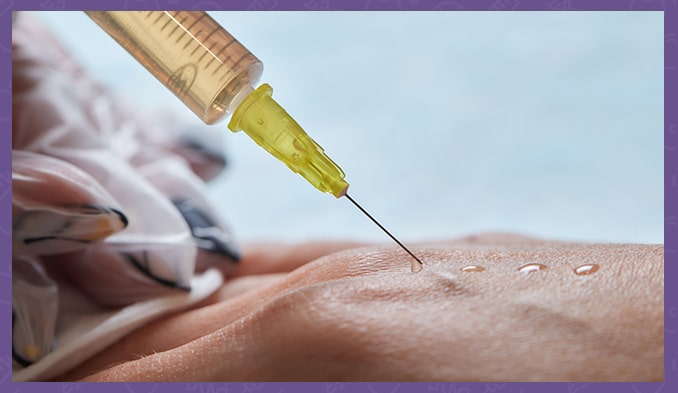Platelet-rich plasma therapy (PRP therapy) is gaining popularity for a variety of conditions, from sports injuries to hair loss. It has been used in many fields such as orthopedics, dentistry and skin care for more than 30 years.
What is platelet rich plasma or PRP?
Platelets are one of the basic blood cells. Their function in blood clotting and their contribution to the recovery process is what makes PRP therapy so common. Blood plasma rich in platelets and injected into the target area quickly starts the recovery process.
To create platelet-rich plasma, clinicians take a blood sample from the patient and place it in a device called a centrifuge, which rapidly spins the sample, separating the other blood components from the platelets and concentrating them into plasma.
After creating a platelet-rich plasma from a patient's blood sample, this solution is injected into the target area, such as an injured knee or tendon. In some cases, the clinician may use ultrasound to guide the injection. The idea is to increase the concentration of specific bioproteins, or hormones called growth factors, in the targeted area to speed up the healing process. Studies have shown that an increased concentration of growth factors in platelet-rich plasma can stimulate or speed up the healing process, shortening the time it takes for injuries to heal, reducing pain and even promoting hair growth.
What is PRP therapy used for?
PRP therapies are used for a range of conditions, from musculoskeletal pain and injuries to cosmetic procedures.
PRP therapy in vitro
PRP can be applied in two different directions in the field of IVF - rejuvenation of ovarian tissue and thickening of the inner membrane of the uterus. If PRP is administered in the uterus, the patient is not anesthetized and the procedure is painless. If it is applied in the ovary it is done under anesthesia and again the patient does not experience any pain. Plasmotherapy is administered to restore ovarian function and to "rejuvenate" the uterus, thus greatly increasing the chances of embryo implantation and successful pregnancy.
PRP therapy in Ophthalmology
Some of the conditions in ophthalmology that PRP therapy can treat:
- Chronic and symptomatic dry eye syndrome - Dry eye syndrome is a condition in which the lacrimal glands do not produce enough tears. As a result, there may be constant irritation in the eyes. Over time, the irritation causes inflammation and even scarring on the surface of the eye. The dry eye condition can affect the cornea and conjunctiva, or the thin tissue that covers the eye and the inside of the eyelids.
- Ocular surface syndrome - eye pain or discomfort, blurred vision or redness and itching. If left untreated, the condition can lead to severe damage to the surface of the cornea and even blindness.
- Corneal ulcers and sores - Corneal ulcers are like open sores in the cornea of the eye. They can form due to injury or infection of the eye or as a result of chemical damage. Drying of the cornea and excessive contact lens wear or abuse can also cause these sores.
- Recurrent Corneal Erosion Syndrome (RCE) - Corneal erosion is a condition in which the thin tissues in the eye that support the cornea wear away. This can result in symptoms such as eye pain, excessive tearing and sensitivity to bright light. Eventually, patients discover that their vision is affected.
PRP therapy for tendon, ligament, muscle and joint injuries
PRP injections can treat a range of musculoskeletal injuries and conditions. For example, chronic tendon injuries such as tennis elbow or jumper's knee can often take a long time to heal, so adding PRP injections to a treatment regimen can help stimulate the healing process, reduce pain, and return to active activity more quickly.
Postoperative healing
Clinicians first used PRP to accelerate healing after jaw or plastic surgery. Now, post-operative PRP injections are being used more extensively to help heal muscles, tendons and ligaments, as procedures on these tissues have a longer recovery time.
Osteoarthritis
Early studies have shown that PRP injections can help treat pain and stiffness in osteoarthritis by modulating the joint environment and reducing inflammation.
Hair loss
PRP injections can be effective in treating male pattern baldness, both to prevent hair loss and to promote new hair growth.
PRP can also help stimulate hair growth after a hair transplant.
PRP in dermatology
PRP-therapy in dermatology can be used for:
- Wrinkle reduction
- Skin rejuvenation
- Improving facial complexion
- Reduction of acne scars
- Reduction of black circles under the eyes
- Melasma
G-shot
PRP is injected into the area around the urethra, clitoris, labia and G-spot to help increase sensitivity, tone and tissue health. PRP injections increase vaginal wall sensitivity at the G-spot, which in turn leads to easier and more intense vaginal orgasms.
Candidates for the procedure may be:
- Women after childbirth
- Women after menopause
- Women who suffer from recurrent vaginal infections
- Mild to moderate stress urinary incontinence
- Vaginal dryness
- Women who feel they have vaginal laxity
- Painful intercourse
Risks and side effects of PRP therapy
PRP therapy is a low-risk procedure and usually does not cause serious side effects. Because PRP injections are made up of the patient's own cells and plasma, the risk of an allergic reaction is much lower than with other injectable drugs such as corticosteroids. Less common risks of PRP injections include:
- Bleeding
- Tissue damage
- Infection
- Injuries to the nerves



